Let’s get real — for a lot of businesses, times are tough. Budgets are being cut, which means your customer or client list may be dwindling.
Retail sales, for example, were down 8% in March of 2020, which is the steepest decline since we started tracking it in 1992.
While there is no specific stat tracking business to business sales, several reports claim that business spending as a whole has decreased dramatically in the last few months.
It’s enough to make most business owners wary about spending money on anything — including marketing.
However, putting the brakes on marketing during financial downturns (in the middle of the COVID-19 pandemic, for example) can be a death sentence for your business.
But you can’t justify investing in long-term ROI strategies during a time when short-term profits are down or unstable.
So, what is the solution?
If you want to survive the current economic landscape, it is time to shift your budget and priority to strategies with short-term ROI by getting more out of the content and resources you already have.
This means looking for ways to get more results out of existing content assets such as blogs, white papers, and evergreen guides.
How do you do that efficiently and effectively at a time when you don’t have resources to spare on maybes?
By looking for ways to fill content gaps, which can drive traffic, sales, and help you build your email list now, not in six months to a year.
Contents
- 1 What is the Content Gap?
- 2 4 Ways to Find and Fix Content Gaps in Google Analytics
- 3 Look at Your On-Site Search Queries
- 4 How to Fill the Gap
- 5 Find Content With a High Bounce Rate
- 6 What is a good bounce rate?
- 7 Protip: Use Secondary Dimensions
- 8 How to Fill the Gap
- 9 Find Good Old Content and Bring it Back to Life
- 10 How to Fill the Gap
- 11 Exit Pages
- 12 What is the difference between Exit Pages and Bounce Rate?
- 13 How to Fill the Gap
- 14 Final Thoughts: Where Google Analytics Falls Short
What is the Content Gap?
First, what do we mean by a content gap?
A content gap refers to topics and key terms your website is currently not targeting, or not targeting as efficiently as it could. Content gaps often refer to content your competitors are ranking well for, but this isn’t always the case.
For example, if you have a site dedicated to reviewing ecommerce tools, you might look for the most popular ecommerce tools by doing a Google search:
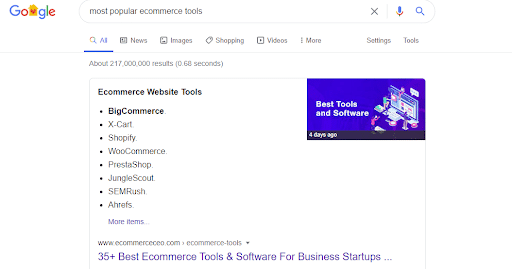
If your site doesn’t currently cover all those tools, then you have a gap in your content that you can fill. You might write an in-depth review of Shopify and WooCommerce.
That, of course, is a simple example.
But content gap analysis can (and should) dig much deeper.
Let’s say you published reviews of WooCommerce and Shopify a few years ago. That means there is no content gap, right?
Not necessarily.
Using Google Analytics, you might discover that those articles used to do really well, but traffic has dropped 50% in the last year.
Your posts are stale, even though you’ve technically covered the topics.
So, it may be time to look for ways to update that content by covering related topics or optimizing your content using a tool like MarketMuse, which compares your content to the best-ranking content.
But, how do you find those gaps?
With a tool, you probably already use — Google Analytics.
4 Ways to Find and Fix Content Gaps in Google Analytics
There are tons of benefits to GA — it provides a tremendous amount of data that you can manipulate, advanced reports, and customization options you can use to dig into your data and get a clearer picture of what works, and what doesn’t.
Did we mention it’s free?
Say you want to figure out what posts drive the most traffic on your site.
Google Analytics has you covered.
With just a few clicks, you can see what pages on your site get the most traffic by logging into Google Analytics and clicking Behavior > Overview.
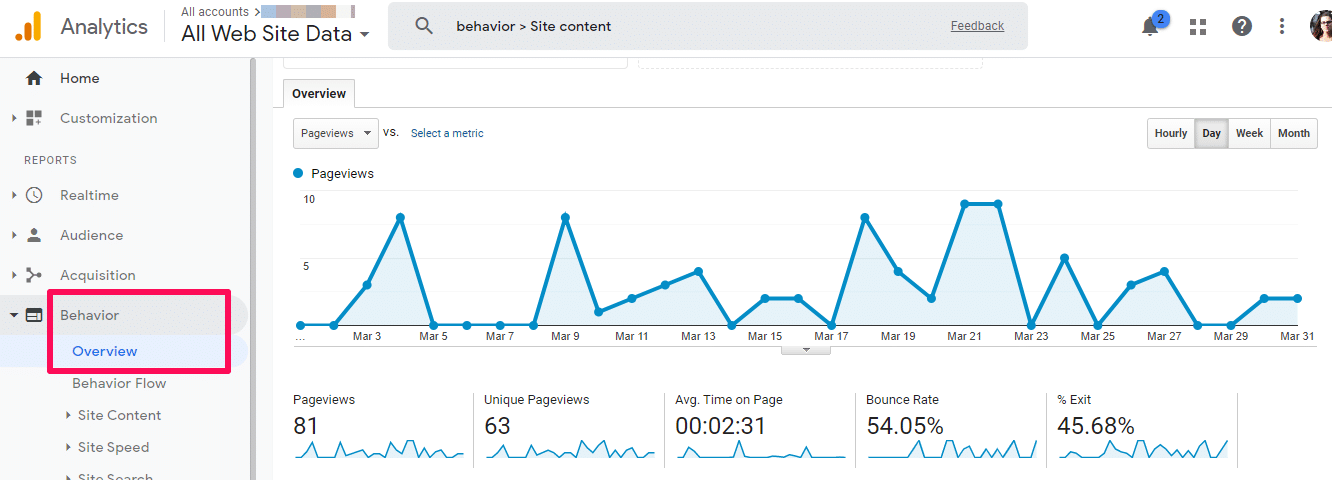
But, as you may already know, Google Analytics can do a lot more — including help you uncover content opportunities you might have missed.
Let’s look at four ways site owners can use Google Analytics to uncover and fix content gaps.
Look at Your On-Site Search Queries
Do you have a search bar on your website? Query data from on-site searches is low-hanging fruit when it comes to fixing content gaps.
Here’s why.
People that used your site search bar are already on your site — that means they’ve already decided that your site could fix their problem, but they can’t quite find the content they need.
Look at how this search results page for a DCIM software, Nlyte, is structured to provide site visitors with relevant results to their query.
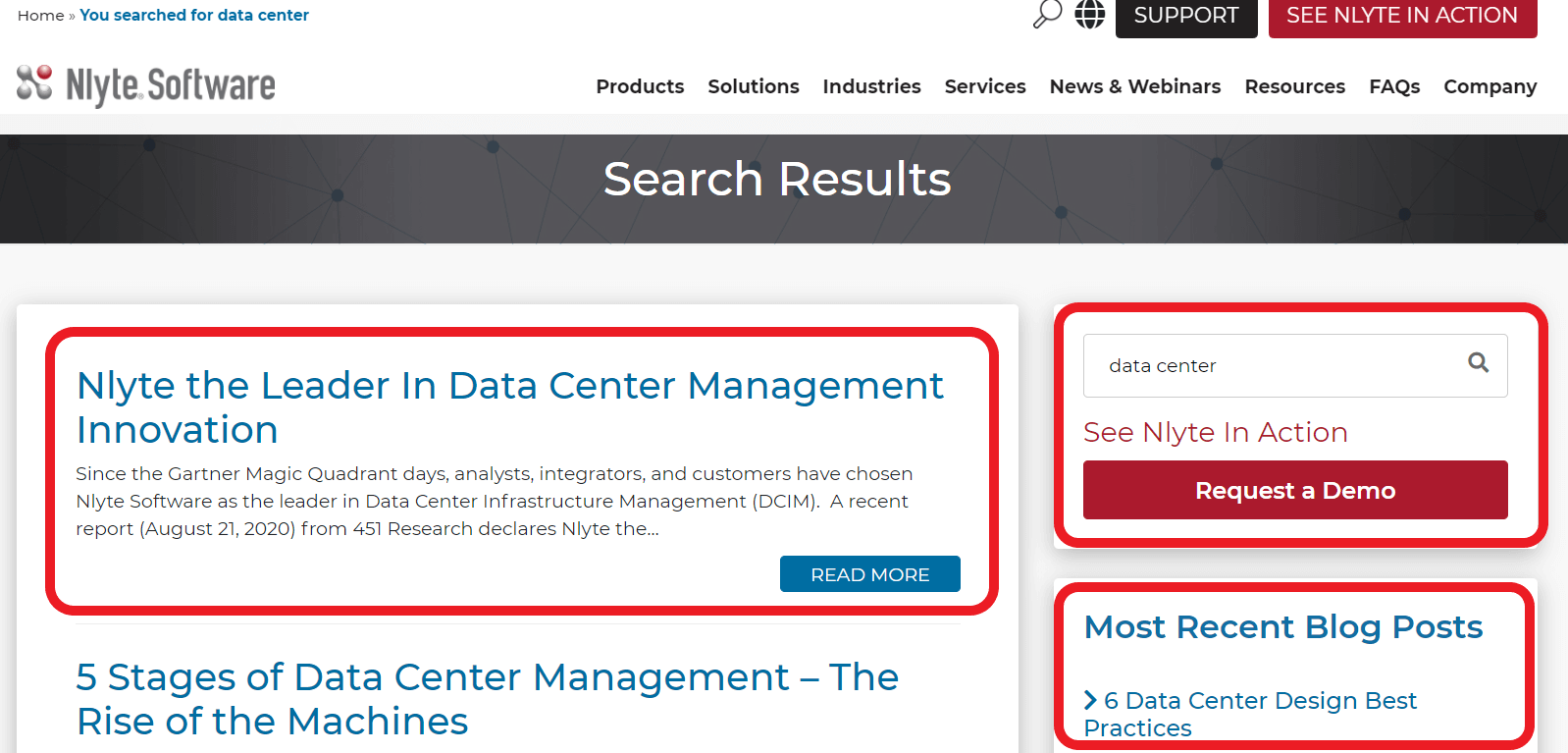
The results page is divided into a CTA for a demo, results from the website’s main pages, and then results from the blog. If there is a content gap on the query, there would be limited results in either one or both of the results sections.
Here’s how to find data about on-site searches.
Login to Google Analytics, then head to Behavior > Site Search > Search Terms. This will show you what queries people are performing in your search bar.
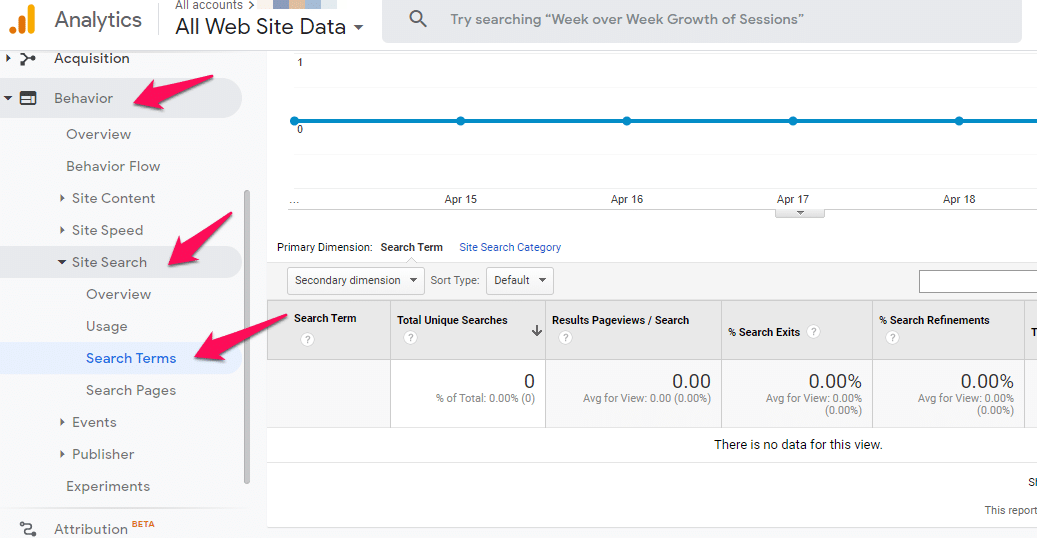
How to Fill the Gap
So what do you do with this search bar data? First, make a list of the top queries. Then, take a peek at your current content.
Let’s say you still have that eCommerce review site, and “site builder” and “Shopify” are the top queries in your search bar.
If you don’t have pages for those terms, then you’ve got a content gap.
You need to create content to fill that gap and most importantly, have a content strategy framework in place.
If you already have pages for Shopify and site builder, then you might need to rework those pages using a content optimization tool like Clearscope, which will recommend related topics to cover or make the pages easier to access.
For example, you might add the most popular search queries to your navigation bar so visitors can find the information they want quickly.
This data is incredibly valuable because you’ve already got those visitors to your site — now you need to provide them with the content they want.
Find Content With a High Bounce Rate
Next, let’s look for content that doesn’t keep users on your website — i.e., those with a high bounce rate.
Google defines bounce rate as the percentage of visitors who enter a site then leave rather than viewing more pages.
Keep in mind, a high bounce rate could mean several things — your content isn’t relevant to your users, or maybe you aren’t using CTAs or internal links appropriately.
Here’s how to find those pages:
Head to Google Analytics, then Acquisitions > All Traffic.
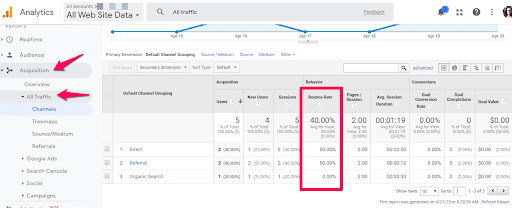
You’ll be able to see the bounce rate of all your content in the column labeled, appropriately, Bounce Rate.
What is a good bounce rate?
In general, a bounce rate above 40% indicates there is an issue with the content.
However, the average bounce rate can vary based on your industry and the intent of your page. For example, a news post might have a high bounce rate because the article was short, and people got the information they wanted and left.
Protip: Use Secondary Dimensions
Google Analytics has a secondary dimension feature, which can help you better understand the causes of an elevated bounce rate. It is located at the top of the All Traffic report here:
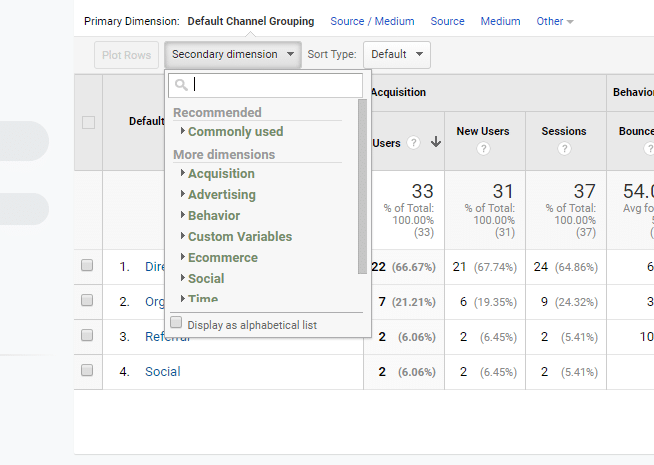
The secondary dimension allows you to filter the data by additional elements.
If you look at Acquisitions> All Traffic, you will see the bounce rate for all traffic that comes to your site.
However, if you add Social Network as a secondary dimension, you can see, for example, if traffic from Twitter or Instagram has a higher bounce rate.

These insights can help you uncover what is causing high bounce rates.
How to Fill the Gap
Once you know what content has high bounce rates, you can dig deeper and look for ways to improve the user experience and shore up those content gaps.
You might:
- Update pages with high bounce rates with newer information and republish.
- Create longer-form content with more engaging elements, such as video or detailed images.
- Add CTAs and internal links to keep site visitors on your site longer.
- Use a grammar tool like Grammarly to fix typos and adjust your tone to match the rest of your site or visitor intent.
High bounce rates mean you are not giving your visitors something they need — it is up to you to figure out what that might be.
Find Good Old Content and Bring it Back to Life
Content gaps don’t just come from topics your site doesn’t cover — they can also be from the great content you created but let get old and stale.
Keep in mind that Google updates its algorithm approximately 976,899,000 times a year (okay, that might be a slight exaggeration.)
The point is, content that did really, really well last year might not be doing as well this year because your competitors published better content, Google updated their algorithm, or it is just plain out of date.
To find good, but old, content in Google Analytics, here’s what you need to do.
Head to Behavior > Site Content, then look at overall page views.
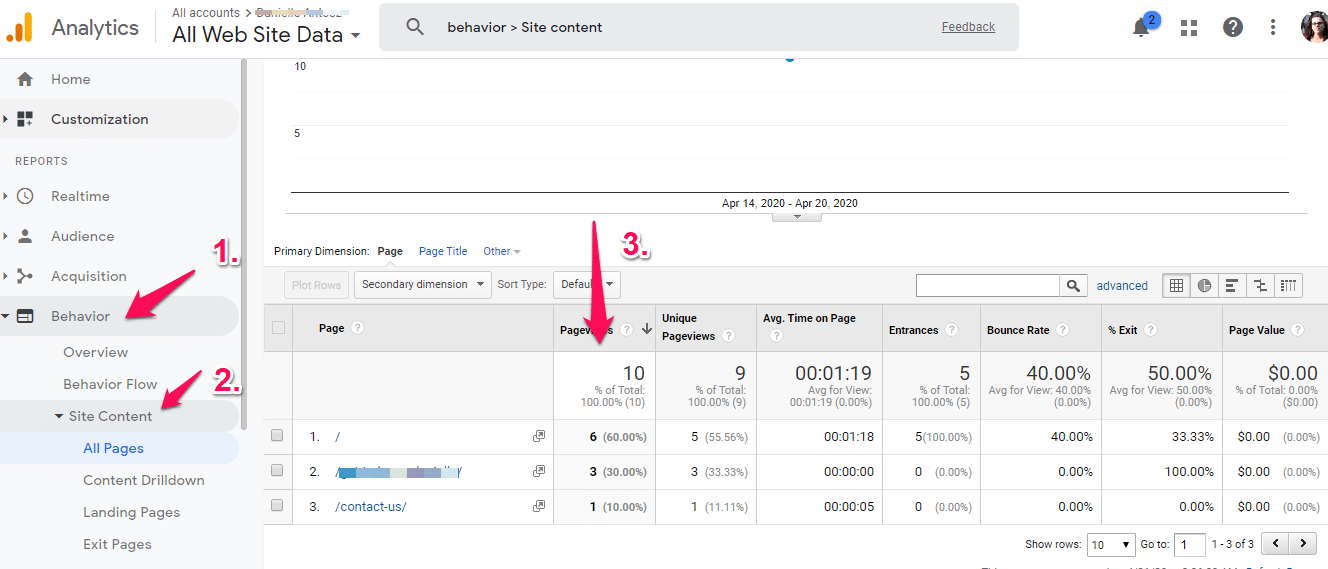
Of course, this will only tell you what pages are popular today, which doesn’t help.
So, head up to the time option at the top of the table, and click to expand.
You’ll see the option to compare, which allows you to compare traffic from this week (or whatever time period you set) to last week, last month, last year, or a custom time period.

How to Fill the Gap
Take a look at pages that did really well last year, but aren’t performing as well this year.
Then, make a plan to update, optimize, or repurpose that content into different formats. For instance, if you have an in-depth guide you created in the past, you may repurpose much of that content and build an online course and offer it as a content upgrade to build your list, or maybe even try to sell it outright.
You’ve already invested time in creating that content — don’t let those resources go to waste by letting that content die.
Exit Pages
Ideally, a visitor comes to your site, reads all your amazing content, and then buys whatever it is you sell.
In a perfect world, anyway.
What happens if they come, look around for a few minutes and leave? Do you know why they left?
This is why it pays to look at Exit Pages.
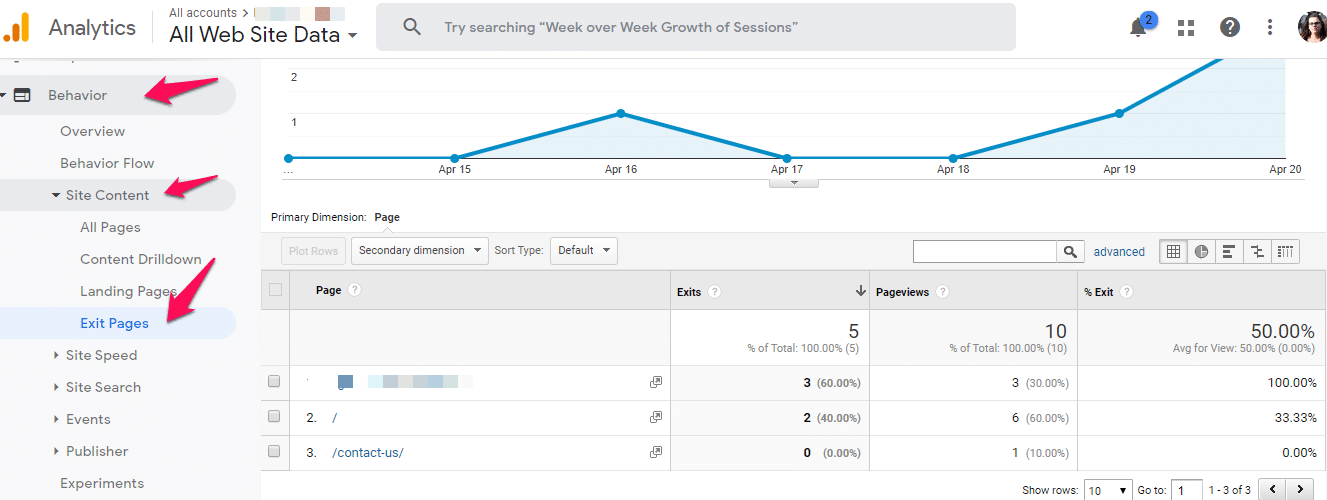
What is the difference between Exit Pages and Bounce Rate?
If you are thinking that looking at exit pages is pretty similar to the bounce rate, well, you are right.
Sort of. Actually, Google calculates these a bit differently.
The bounce rate is the percentage of single-page visits. This means visitors who look at just one page on your site, then leave.
Exit Pages refers to the last page people look at before they leave your site, no matter how many pages they looked at.
Now, if your highest Exit Page is your “Thank You For Your Purchase” page, then you are doing pretty good.
However, if your highest exit page is a blog post or your services page, well, then it’s time to make some changes.
How to Fill the Gap
Once you’ve figured out what pages have the highest exit rate, you’ll need to dig a little deeper to figure out why people are leaving.
The reason, of course, will vary based on details unique to your industry, website, and customer base.
Here are a few ways to lower the exit rate of your pages:
- Avoid popups and other UX features that disrupt your content’s readability.
- Make it scannable — break paragraphs into smaller chunks, add bullet lists (hey-o), bold text, and images.
- Add actionable CTAs, such as email list sign-up.
- Check your site speed using Google’s PageSpeed Insight tool to make sure slow loading pages aren’t scaring visitors away.
Visitors are going to leave your site at some point, right? (They can’t stay there forever.)
Your goal should be to get them converted in some way before they leave — which might mean making a purchase or subscribing to your email list.
Final Thoughts: Where Google Analytics Falls Short
Google Analytics excels at providing a massive amount of top-of-the-funnel, aggregate data. However, there are some drawbacks. If you aren’t familiar with the platform, it can be overwhelming to dive straight into data analytics.
Google Analytics is also ‘session-based’, which means it looks mostly at individual visits. This can create a last touch bias, which places more value (or blame) on the last page or action a visitor took before leaving.
It also doesn’t provide access to competitor data, which can be a crucial part of performing a content gap analysis. If your competitors are ranking well for topics you don’t even touch on, then you have a considerable content gap to address.
Despite its challenges, Google Analytics is a valuable tool for site owners looking for ways to use the content they already have to get quick wins during a time when resources can be hard to come by.
Want to learn more about how you can improve your current content and plan for economic growth in the future? Contact us for your free content analysis.
Happy Reading!

